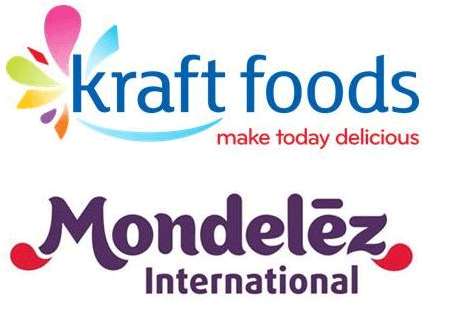Kraft Foods CEO Irene Rosenfeld’s broke up the food giant into two separate companies by separating its snack foods lines from its grocery brands. Rosenfeld believed that the snack food company would be a high growth, international business while the grocery company would be a stable but slow growth business. On October 1, 2012, Kraft Foods Inc. spun off its North American grocery business to a new company called Kraft Foods Group, Inc. The remainder of Kraft Foods Inc. was renamed Mondelēz International, Inc. and was refocused as an international snack and confection company. The two companies were created through a tax-free spin-off of the North American grocery business to Kraft Foods shareholders.
Kraft’s Rosenfeld was instrumental in developing Kraft’s snack business in part by the acquiring LU biscuit from Danone and Cadbury. The snacks company included Kraft Foods Europe and developing markets units and the North American snacks and confectionery businesses. The non-snacks component of the business included mostly powdered beverages and coffee. The new Kraft Foods Group’s mission was focused mainly on grocery products for the North American market while Mondelēz was to focus on international confectionery and snack brands. In 2015, Kraft Foods Group Inc. merged with the H.J. Heinz Company to form The Kraft Heinz Company, the world’s fifth-largest food and beverage company.
Ever since Kraft’s acquisition of Cadbury in 2010 some analysts have predicted the Mondelez spin-off. While some believed that the split was in reaction to mass retailers like Wal-Mart and Target Corp. expanding their grocery sections the primary reason for the move is because the capital requirements of the two business were quite different. The company’s snacks lines including Cadbury chocolates, biscuits, Oreo cookies, Tang, etc. and these were popular in fast-growing developing markets where Rosenfeld thought they could significantly expand sales. The rest of the business was anchored by more mature North American grocery brands (Jell-O, Maxwell House, Philadelphia Cream Cheese, Miracle Whip and Oscar Mayer meats) which offer high-margins but where growth comes more slowly. According to CEO Rosenfeld, the snacks business needed lots of spending to grow and expand whereas the North American grocery business will be a “lean, mean center-of-the-store machine.”
In short, it all came down to capital requirements. Essentially Kraft was always running two different businesses – each had different needs, different strategies and different growth prospects. The grocery company grows slowly but still is able to return cash to its investors and the snack company grows faster. As separate entities, each company can access capital in ways that make sense for the business needs while allowing investors to choose between placing their bets with either a slower growth, dividend-paying company, or a higher-growth, company.
In 2016 Kraft Heinz had revenues of $26.48 billion while US Mondelez International had an annual revenue of about $25.92 billion. A list of most of the brands developed and/or managed Kraft Foods, Kraft Heinz and Mondelez can be found here.

